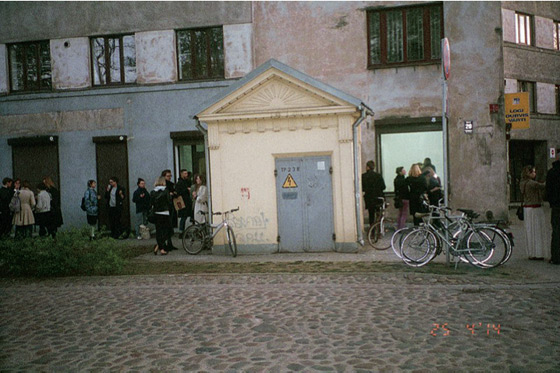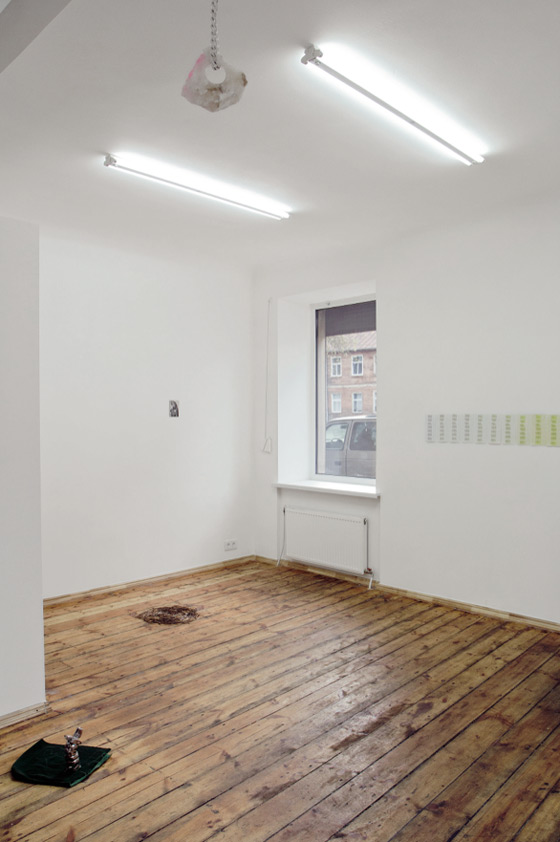|
|
| Heading Kaspars Groševs, Artist | |
| In writing these lines, artist charles demuth’s words entangled in my sentences like little children who mischievously hamper the recitation of: there is no stopping, most stop... there is no stopping.... the lines of this poem, which demuth dedicated to richard mutt one hundred years ago, banged against the white walls and became a bubbling soundtrack for the exhibition Farewell, with which the four to seven gallery, or 427, was opened at the end of april. of late, i sometimes tend to sit here at elijas iela 20 – as the name states – from four to seven, listening to the despatched voice of lithuanian artist augustas serapinas whilst hanging out the window, past which dark grey, crumpled silhouettes and girls’ pigtails sometimes quickly run. One can arrive at elijas iela inadvertently, for example, following the sparkling river on a warm summer’s day or losing one’s way from maskavas iela and gogoļa iela, the traffic arteries of the maskava suburb. most of the people here are unhurried, but the better the weather gets, the more frequently they sit down on the steps of the church of jesus. now and then, people with amazed looks and bulging backpacks provide a reminder that the church of jesus is a tourist site – the building, constructed in the 17th century, is one of the largest wooden churches in europe. the 427 gallery will operate here, right here, at a place where the thoughts of many people in riga very rarely enter and the dark windows and cracked walls perfidiously portend of lower rental rates. | |
 Opening eve of 427 gallery. 25.04.2014 | |
| I must admit that i truly don’t recall the day that ieva (ieva kraule is an artist and co-founder of the gallery – ed.) found the advertisement for a crowded space behind, or in front of, two of the neighbourhood’s colossi: the church of jesus and the academy of sciences. it seems that the idea of a space for artists’ activities, which should be made into a stopping off point on a walk around riga, was also just hanging in the air. like a word on the tip of the tongue, still waiting for the next syllable. And so, 427 decided it would become an art gallery for a brief period until it becomes a restaurant,1 which will be dedicated to only one dish and variations thereof. first of all, before the space became a gallery, a door was required. and a whole three of them were found: one was hidden (just like a euro-renovation version of duchamp’s Étant donnés – a wooden door with a peephole in it to look through!), the second one was always locked, and the third was sometimes open. but behind one of the doors are we, who bid and at the same time receive a transparent Farewell! its round vowels could, possibly, sound like the name of a spying operation or a suburban pub’s signboard. like a farewell salute prior to acquaintanceship, Farewell wished a successful journey or confirmed its progress, in any case urging one to keep moving on. but an accident before the event became a guide-book for the creation of the first exhibition. Continuing on from the uncertain expectations, Farewell first of all approached nine artists – augustas serapinas, līva rutmane, OaOa, lev kazachenko (Лев Казаченко), linards kulless, marija olšauskaitė, vivienne griffin, jóhan martin christiansen and jānis avotiņš – and invited them to respond with a suitable work for the exhibition. along with farewells and greetings, the artists received instructions – three questions, a fragment of a poem, a small graphics reproduction, a graphic reproduction that seems to swirl about – as well as money for the return trip in a packet of Dirol Senses chewing gum. the artists may possibly allege something different regarding the contents of the post box. in the end, the parcel addressed to marija was returned unopened a number of weeks after the opening of the exhibition without having reached the address, and jānis avotiņš never sent a reply but merely promised to think about what could or couldn’t be placed in the box. even before opening a packet, Dirol Senses promised a Mega Mystery, but, on opening it, one was invited in various languages not to reveal the secret. following in līva rutmane’s footsteps, whose response for the exhibition was copied, faded notes about what could be found in the chewing gum packet, i gradually chewed all seven feelings, only to admit that, even if i wanted to, i wouldn’t be able to reveal the secret. linards kulless chased the secret for a number of days straight, engrossed in unworldly expanses, until he decided to use holographic paper as an invitation to become a travelling companion as the response’s binding medium. | |
 View from the Farewell exhibition. 2014 Publicity photo Courtesy of the artists and 427 Gallery | |
| Lev Kazachenko’s parcel rattled lightly, with short, medium-short, medium and medium-long twigs having arranged themselves in a hexagonal nest. it’s possible that they sensed elijas iela was once called odessa street for many decades, but they may have possibly been announcing a thunderstorm in amsterdam, through which the postman had forced his way to bring lev both Farewell and a blizzard. not much is known about the circumstances in which jóhan martin christiansen received his self-addressed parcel; however, the thought of the retreat of winter became a guidebook for his response – a winter dress that, like a daguerreotype, had caught some moment ‘after’ (and why not maybe ‘before’?). like a guard wrapped in a cloak, it covered the voice sent by augustas serapinas, which repeated the short lines of text over and over, becoming a part of the roomtone, which simultaneously participated and, while resting, lived in the corners of the house. the OaOa figurine on green velvet reflected the space as well, growing into it in a similar way as the o and a transform into two reflections. the shiny folds could dazzle a person, but for another they whispered about riddles and mysterious dialogues over the ocean. but why couldn’t the answer outpace the question, with the end of the discussion becoming its beginning? olšauskaitė’s black-and-white collage provided a response to what was still to follow. but vivienne griffin’s response got lost on the journey, carrying Farewell further than hoped, and the artist’s comment became her response. it hung above the ground like an unspoken insult, silently communicating about those entering and those who had gone. What’s worse – a broken chair or an uncomfortable chair? at a time when loud invitations to conjure up new spaces are the norm, it seemed important to count not just square metres and cubic metres but also ideas, even though they may be upside down. that’s why 427 is firstly an idea – an idea cloaked in words. it could clumsily stumble around or fly up into the air, and only afterwards would it occupy some tens of square metres covered by worn planking. Farewell initially wanted to be a spoken word, too, which didn’t disappear on exhalation but got repeated until it became an event. where? that wasn’t of so much significance, and randomness continued its course until the run-down corner of elijas iela 20, the locks of which were more often locked than unlocked, became a punctuation mark in the paragraph. Translator into English: Uldis Brūns 1 ieva kraule’s Nobody Dances Like That any More exhibition, which, among other things, will also provide snacks to guests from a specially prepared menu, can be viewed in early june at the 427 gallery. | |
| go back | |







